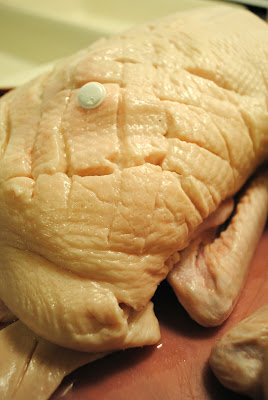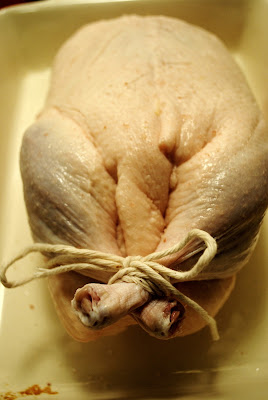 Okay, this is another of the dishes that I completely neglected to photo-document. I was dutifully taking photos of the process...until I started to run out of time. I literally pulled the ducks - gorgeous mahogany ducks! - out of the oven 10 minutes before we were due to be at my parents' house for our feast. Yikes.
Okay, this is another of the dishes that I completely neglected to photo-document. I was dutifully taking photos of the process...until I started to run out of time. I literally pulled the ducks - gorgeous mahogany ducks! - out of the oven 10 minutes before we were due to be at my parents' house for our feast. Yikes. It was delicious...and the declared favorite of at least three dinner guests. But I have no finished photos. So sorry! I think that means that I will have to do this again. Soon. I promise. And I made a delicious glaze with the ripe Hachiya persimmons from a friend's tree. Thanks, Shiho!!
Does the idea of roasting a whole duck intimidate you? Don't let it. This is so simple...it just takes time...and a little bit of patience.
Here’s the basic technique: 4 hours at 300 degrees, glaze, then finish it at 400 degrees for 7-10 minutes.
Here's a more detailed how-to...
Unwrap the bird and remove all of the giblets from the duck's cavity.
Unwrap the bird and remove all of the giblets from the duck's cavity.
When your duck is empty, rinse it under cold water. Pat it dry with paper towels. Sprinkle the cavity with some salt. I used freshly ground sea salt from the Monterey Bay Salt Company.
With a sharp knife, score a diamond pattern into the duck skin on
the breast. Slice very carefully - you want to cut through most of the fat without
cutting into the meat. As luck would have it, a duck’s layer of fat is fairly thick. So this process is relatively easy once you get the hang of it.
Poke the duck’s skin all over with a sharp knife, creating small holes through which the fat can escape more easily. Only prick the skin, try not to poke the meat.
It's time to truss the duck! Cross the legs and tie them together like this with a piece of
butcher’s twine.
Now it goes into the oven, breast side up.
After the first hour, pull the pan out of the oven. The skin will still be pale, but should be a little bit crisp when poked. Pour off the duck fat into a separate container; I used a large mason jar.
Prick the skin all over with a knife. When pierced, the skin should let out more molten duck fat. Make sure to get the area around the legs, which is particularly fatty.
Flip the bird over, so it’s breast-side down. Pour off more of the duck fat. And pop it back into the oven, breast-side down, for another hour at 300
degrees.
After the second hour, pull the pan out of the oven. The skin will be
browner, and more crisp. Prick the skin all over, again and flip the bird breast-side up. Pour off the duck fat again. This is where I stopped taking photos. Sorry!
Put it back in the oven, breast-side up, for 1 more hour at 300
degrees.
After the third hour, remove the pan from the oven. Your duck should be
significantly browner and getting more crispy. Prick the skin all over, pour off more fat, and pop it back in the oven. Roast breast-side down for a final hour at 300
degrees.
 While the duck is roasting for its last hour, make the glaze...
While the duck is roasting for its last hour, make the glaze...
2 T butter
1 C Hachiya persimmon pulp, mashed
2 T minced garlic
1/4 C coconut sugar
1 C freshly squeezed clementine juice
1 T ginger syrup
1 T soy sauce
In a medium-sized saucepan, combine all of the ingredients and bring to a simmer. Cook until thickened. Remove your glaze from the heat.
After the 4th hour in the oven, pull the pan out of the oven and raise the
heat up to 400 degrees.
Brush the duck with glaze so that it's completely covered. If your glaze has cooled and is too thick to spread, just warm it up on the
stove and it’ll liquify right up.
Stick your pan back in the oven, and roast at 400 degrees for 7-10 minutes - just until your duck is a beautiful brown color. Keep a close eye on it,
and pull it out if it starts to burn.
I wish I had taken photos of the duck. It was beautiful! I served these with a fresh Cranberry-Clementine Relish and Boozy Cranberry Sauce.
I wish I had taken photos of the duck. It was beautiful! I served these with a fresh Cranberry-Clementine Relish and Boozy Cranberry Sauce.





Comments
Post a Comment